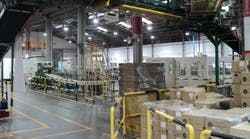With a global footprint spanning more than 150 countries, Kimberly-Clark (K-C, www.kimberly-clark.com) touches the lives of more than a billion people. At its Family Care production facility at Kluang in Malaysian state of Johor, the company manufactures paper products including Kleenex facial tissues and Scott paper towels. Aiming to reduce energy consumption and improve visibility within the plant, the company recently replaced 114 of its 400 W metal halide lighting fixtures with DuroSite LED high bay fixtures from Dialight (www.dialight.com). Consuming just 123 W, the Dialight high bays enabled the company to reduce energy consumption and improve visibility while making the work environment more comfortable and safer. The company has been so impressed with the results, it’s now considering an upgrade to Dialight fixtures at other areas within the mill.
Time for an upgrade
Kimberly Clark was able to achieve a 60% reduction in energy consumption and a lighting efficacy of 4 W/m2.
When the Family Care production team noticed low brightness on the manufacturing floor, the K-C engineering team set out to find technology to upgrade the lighting. One of the biggest factors contributing to the low light quality, besides the rapid light depreciation natural to metal halide bulbs, was the degradation of the polycarbonate shields covering each fixture. In the event a lamp should burst in the overhead fixtures, the shields were designed to prevent a possible spark from igniting the tissue products on the manufacturing floor — a major safety concern. But over time, the shields had become faded and discolored, further reducing clarity. The shields also were prone to collecting insects, which further reduced effective light output. Poor visibility was especially an issue in the inspection areas, where low light conditions hindered the K-C quality assurance team’s efforts.
Furthermore, because of the region’s tropical climate, heat inside the facility also was a problem. The high-heat metal halide fixtures contributed to this problem, which drove employees to switch off the lights to keep the temperature down. But, with the long restrike/warmup times required for the lights to come back to full output, this presented a safety concern.
Sustainable manufacturing
The Kluang facility’s current lighting efficacy was 12.49 W/m2, mostly because the lights were illuminating unnecessary areas and were often left burning when not needed to avoid the wait for restrike/warmup.
As the K-C team began evaluating options, they immediately looked to LEDs and even considered solar-powered products. They evaluated products from local suppliers, including LED companies from Singapore and China. However, the North American-made Dialight high bays claimed better efficiency, shorter payback, and a longer lifespan backed by a five-year warranty. The company’s global reputation and list of customers also were determining factors. With an installed base of more than 50,000 LED high bay fixtures, Dialight’s global presence gave K-C facility managers the confidence that they’d chosen was a trusted solution. The K-C team also was impressed with the 3-D lighting simulation provided by the regional distributor of Dialight lighting products, Lumina Systems, which gave them a preview of the results before the fixtures were ordered. “With the lighting simulation, we could see clearly the optimum lighting layout for the space to be illuminated,” says Adam Lua Boon Chin, project engineer, Kimberly Clark Products. “We knew before installing the lamps that light would be directed exactly where we need it”
Energy, maintenance costs shrink
Because of the Dialight LED’s instant-on capability, K-C also is free to turn off the lights when they’re not needed and can strategically light only certain areas of the facility, such as alternating rows or only the perimeter, to save on energy use. The K-C facility reduced its electricity costs with a 60% reduction in energy consumption. And lighting efficacy is at 4 W/m2, less than a third of that of the metal halide units. Changing bulbs in the metal halide fixtures not only interfered with production but also posed a safety hazard, as most of the lights were positioned above manufacturing equipment. Because the Dialight products are expected to last as long as a decade without bulb changes, K-C also has potentially reduced maintenance costs and demands at the facility. Because the lights are fully enclosed and sealed to meet the HACCP and AIB food safety requirements, the risk of bursting bulbs and the problematic spark shields are gone. The lights also are much cooler, operating at less than 46 °C. “Not only have the products performed exactly to our expectations, Dialight has provided us with thorough and professional support, which also has been very important for making this project a success,” says Chow Weng Leong, engineering manager at the facility.
